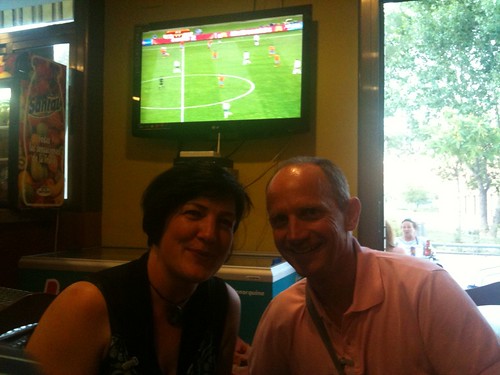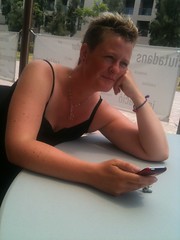[This is a cross-post from Joyce’s blog at www.cats-pyjamas.net]
I’m really looking forward to the PLE Conference 11-13 July 2012. The conference continues to innovate in many ways. Organisationally we’ve expanded the conference to two locations, Deakin University in Melbourne, Australia and Universidade de Aveiro in Portugal, spreading the opportunity for sharing scholarship around the PLN and PLE topics and effectively making this a blended conference. How neat! (Of course, one of the venue organisers for Melbourne is yours truly so I’m a little bias…;-))
The two locations have a joint Call for Papers out with the closing date for abstracts on 16 March 2012, and the deadline for final papers on 13 May 2012. I’m hoping to encourage you all to write an abstract, submit it and join us!
So why should you go to the PLE Conference?
I was very lucky to attend the first PLE Conference in Barcelona and some firsts are simply things which cannot be guaranteed for subsequent events. This first iteration was a veritable who’s who of networked learning with Alec Couros, Steve Wheeler, Graham Atwell, Ilona Buchem and many others in the field attending. Besides the excitement of this, it being the first conference, it also meant that much of the PLE work presented, was completely new to the other attendees. So it was like finding a treasure trove of PLE/PLN research. Also Ricardo Torres Kompen was just the best venue organiser/host, his attention to detail and calmness without peer.
So what are elements of the PLE Conference that continue to make it THE event for any networked scholar/educator to attend?  Well some of us “PLE goers” have shared our experiences and reasons on this Corkboard for you to read. But I thought I would expand on my reasons below, using some of the artefacts I collected in 2010.
Well some of us “PLE goers” have shared our experiences and reasons on this Corkboard for you to read. But I thought I would expand on my reasons below, using some of the artefacts I collected in 2010.
1. Connecting with those you are already connected with
I’m a Twitter evangelist, and an enthousiastic Facebook user. I love communicating with social media because they allow me to connect with like-minded people, people who intersect my interest niche. And I love it whenever I meet these people in real life (so much so that I’ve got a So you’re real after all! set on Flickr). Not because of the coincidence, nor the look-who-I-met factor, but because thanks to social media filtering, it is always an intense and very enjoyable occasion to meet one of these connections. We have so much to say and share with each other, and can build so much on each other’s ideas in a very short time, fueling our interests and thinking until we meet again. All of the people at the PLE Conference are of this variety. Alec Couros touches on this too in the interview I did with him.
It’s been really neat that people who have been connected over years, you yourself included, someone I haven’t had a chance to meet … Actually, you build a sense of friendship over a long time… and when you actually get to meet each other,… you can get right to the sort-of deep conversations. Because these deep conversations have been going on for a long time. That’s really the difference with the dry academic sterile type conference…When you come to a place, you can actually just get to the matter, get to the content that you’re looking for. I think that’s really quite powerful. – Alec Couros
2. This is a growing field!
Personal learning environments, personal learning networks, networked learning. It’s all very new but maturing rapidly. In his video interview Graham talks about 5 or 6 years old and PLE scholarship needing some space to come of age.
Sometimes, the discourse and the dialogue … around PLEs tends to gets lost in the big conferences, and especially tends to get lost behind educational technology, and I don’t see PLEs as being primarily about educational technology. – Graham Atwell
3. Now in the Southern Hemisphere!
In 2010 Colin Warren and I (pictured here) were 2 out of maybe 6 Asia-Pacific participants. Most of the research presented was conducted in Europe, in the European context, with European funding models, in European higher education institutions. Of course, Asian, Pacific, Australian and New Zealand organisations work in different contexts, with different funding models, different education systems, policies, cultural differences, geographical differences, etc. So our uses, considerations and views of PLEs, PLNs and personalized learning will be different too. Having the PLE Conference in Melbourne, allows more people outside Europe to contribute to the body of work.
4. Anything goes
If you’re tired of traditional paper presentations, would like to try a different approach, a PLE Conference is the ideal place to mix it up . In her video interview, co-organiser of the 2010 conference Cristina Costa says:
We wanted to challenge how conferences have been done for decades.
And they did:
- In 2010 Crowdvine was used for pre-conference communication and connection building and people were posting to it even 6 months before the conference dates.
- The 2010 Twitter hashtag #PLE_BCN was coined and correctly promoted by the organisers, creating a vibrant Twitter stream which became a community of itself. That hashtag is still alive today, co-habiting with this year’s hashtag #PLEConf.
- The unKeynote of 2010 was a collaboration between Alec Couros and Graham Atwell, crowdsourcing ideas on topics and formats via Google Docs and encouraging in-room and external participation during the unKeynote
- Why should a conference be closed? Most of the 2010 sessions were streamed live from Citilab, sharing research findings and thinking straightaway, and encouraging participation, questions and comments via Twitter from inside and outside the conference. It widened the conversation and was greatly appreciated by many, although when @evilsue got involved things turned a little messy ;-).
- The introduction of Pecha Kucha sessions allowed many participants the opportunity to present
- In 2010 (and continuing in 2011) Ilona Buchem set up The PLE Media contest, a way for participants to present their PLE work or thoughts in a 3 minute video/animation, leading to such little gems as this one describing the PLE tools in place at the TU Graz.
The conference organisers are using the successes above to inspire this year’s event, but we also have a call out for you to put your thinking caps on and devise other presentation options. Your imagination will be the limit…
5. Creativity is rewarded (and very much appreciated)
As you can see from some of the examples I gave above, creativity is rewarded and appreciated at a PLE Conference. In fact, it starts right as you walk in the door and create your own badge (or put on the one you made earlier). After all, what is more personal than how you introduce yourself to others?
PLE Conference Badges, a gallery on Flickr.
And this theme of personalization and creativity runs through the whole conference. Whereas traditional conferences leave behind only a few torn paper posters, crumpled standard badges and a thick book of proceedings (most of the time only available to attendees and those who pay for access), the PLE Conference leaves in its wake a trail of open artefacts, like a rich twitter archive, YouTube and Vimeo videos, blog posts by the participants, Flickr photos documenting the event, creative slidedecks on Slideshare, and collectively taken notes in Google Docs. We look forward to seeing where you take it this year…
6. You can be on your iPhone and not be rude
And last but not least, at a PLE Conference, everyone is like you. We are all committed to monitoring our streams, to finding those juicy tidbits, to sharing what we hear, to publicly posing our questions or comments. And so it is perfectly all right for you to whip out your iPhone, smartphone, iPad or whatever device of your choice, in the middle of a conversation. In fact, we encourage it. After all, you’re amplifying and sharing what we’re all learning about PLEs, aren’t you?
See you all in July!











